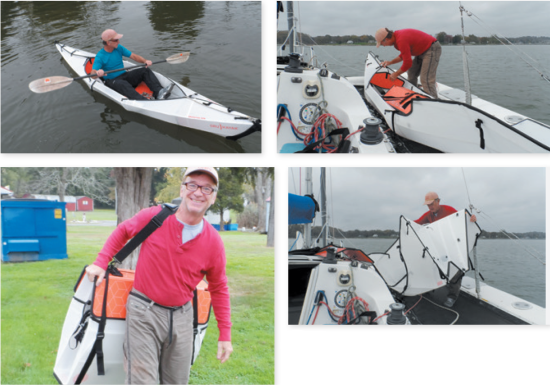No space to store a dinghy or hard kayak? Remember folding paper boats as a kid? The Oru folding kayak neatly solves the first problem and is WAY better than the latter. We recently got a chance to test the Beach LT ($1200). Winter stopped us short of completing our review—you’re not supposed to fold it below freezing—but our initial impression is that there is a lot to like about this new approach.
The hull exterior is formed from a single sheet of very heavy duty corrugated polypropylene, held in shape by a few bulkheads and secured with nylon straps. After removing the carrying straps, you pull two specific points and watch a slender, mostly flat boat emerge from the suitcase sized package.
We spent another 10 minutes fitting the bulkheads, floor, seatback, tightening straps across the top, and securing a pair of neoprene bra-like closures fore and aft. Once assembled, the boat was easily launched from the boat or shore.
The Beach LT weighs in at 26 pounds (hard kayaks in this class are about 45 pounds), which combined with smooth lines makes for easy launching and fast, responsive paddling, much better than the inflatables we’ve tested.
There’s lots of room in the cockpit for groceries and gear, but we’re still evaluating the load carrying and rough water capabilities. This is primarily a harbor kayak with low gunnels. Oru makes more seaworthy versions that are more complex to assemble and a bit more expensive. Which model is best depends on how you will use it.
The hinges are rated at 100,000 fold cycles and Practical Sailor’s reader feedback regarding durability has been good. Online reviews seem variable; some of this is because the early models had simple faults that have been largely resolved, and part is likely the unique nature of the boat. Do not use or fold your Oru kayak in air temperatures below freezing (32°F/0°C). The kayak’s plastic hull can become brittle and crack at temperatures below freezing. This warning is why we have not completed our review; it’s winter on the Chesapeake, and we’re too close to that temperature too often.
But spring is coming. Keep your eyes open for a full review, once we’ve had a chance for multiple testers to really put her through her paces.
ORU KAYAKS,
www.orukayak.com





































ORU also has a tandem kayak that can be made in to a single. It has a 500# weight capacity, so it can carry plenty of stuff-especially with ONE paddler on board.
I just saw one of these kayaks on Lake Union, in Seattle, while I was paddle boarding. Looked stable. And since I’m in the market for a 40 foot cruising sailboat, I want to carry two kayaks with me. The ORU just might do the trick.
Your link for Oru has an error. The text itself is correct, but the hyperlink uses orukayaks.com (there’s no S in the actual URL). Thanks for the tip with them!